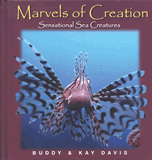
Glowing Glory
From the verdant hills of Ireland and the fuchsia swirls of the aurora borealis to the turquoise waters of the Caribbean and the flash of scarlet cardinals on snowy branches, God’s creation pulses with colors sometimes too vibrant to comprehend. Humans can perceive around one million colors and shades, yet additional colors exist beyond our sight.
God made our eyes to filter out colors in the ultraviolet and infrared spectrums to protect us from harmful rays. Some animals, however, are equipped to view colors in these ranges. With UV (or black) lights, we can glimpse the hidden fluorescent world that animals experience.
Just about everywhere they shine their UV lights, scientists spot fluorescent creatures. Hedgehog spines look dipped in white paint. A flying squirrel turns bubblegum pink. A host of flowers show up and shine. Chameleon bones glow blue through the skin. Puffin beaks blaze with neon hues. A mammal called a springhare sports blotches of pink and orange. And, among its many other oddities, the platypus glows blue green.
These animals and plants likely possess such coloring and the ability to see fluorescent colors for different reasons: defense, camouflage, mating, pollination. Far from mere aesthetic, color plays an intrinsic role in the world—even color we can’t normally see.
What else, I wonder, lies beyond our limited perception, unassumingly bringing glory to the Creator of all things visible and invisible?
Answers Magazine
October–December 2021
Curious about creation but don’t know where to start? Let’s begin with the basics.
Browse IssueRecommended Resources

Answers in Genesis is an apologetics ministry, dedicated to helping Christians defend their faith and proclaim the good news of Jesus Christ.
- Customer Service 800.778.3390
- Available Monday–Friday | 9 AM–5 PM ET
- © 2025 Answers in Genesis





